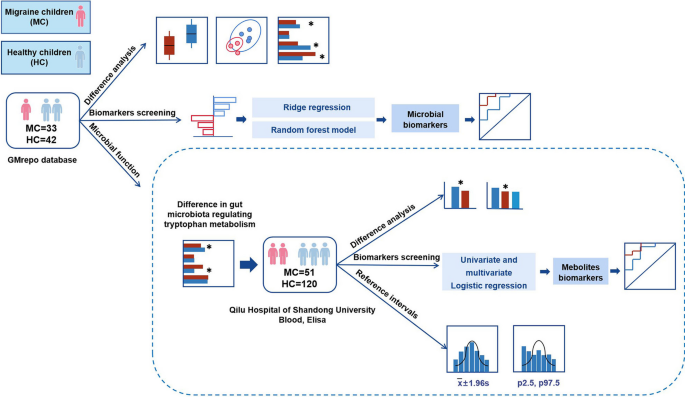💡 The pathogenesis of pediatric migraine remains elusive, posing diagnostic challenges. Recent evidence suggests a potential link between the gut microbiota, tryptophan metabolism, and pediatric migraine through the gut-brain axis. This study aimed to investigate the association among gut microbiota, tryptophan metabolism, and pediatric migraine, identifying potential diagnostic biomarkers.
📍 Methods : Gut microbiota composition in 33 migraine children and 42 healthy children under ten years was analyzed using various metrics, and diagnostic biomarkers were identified. Plasma concentrations of tryptophan metabolites in 51 migraine children and 120 healthy children under eighteen years were compared, and diagnostic value was assessed using ROC curves.
📍 Key Findings
📌 Gut Microbiota Dysbiosis: Migraine children exhibited significant differences in gut microbiota composition, including reduced richness and diversity. Increased abundances of 𝘗𝘳𝘰𝘵𝘦𝘰𝘣𝘢𝘤𝘵𝘦𝘳𝘪𝘢, indicative of microbial dysbiosis, were observed in migraine children.
📌 Diagnostic Microbial Models: A microbial diagnostic model comprising seven genera demonstrated high sensitivity and specificity, providing a promising noninvasive diagnostic tool for pediatric migraine.
📌 Tryptophan Metabolites Alterations: Migraine children showed dysregulated tryptophan metabolism, with a significant decrease in plasma kynurenic acid (KYNA) levels and an increase in serotonin (5-HT) and quinolinic acid (QUIN).
📌 Diagnostic Value of Metabolites: The ratio of KYNA to QUIN exhibited excellent diagnostic efficacy (AUC: 0.871, sensitivity: 86.3%, specificity: 83.3%) for pediatric migraine, providing a potential diagnostic marker.
📌 Enzyme Activity and Pathway Dysregulation: Analysis of enzyme activity ratios (KYNA/KYN, KYNA/QUIN, QUIN/KYN) suggested dysregulated kynurenine pathway (KP) enzyme activities, indicating potential involvement of KP in pediatric migraine pathogenesis.
📌 Reference Intervals and Protective Factors: Establishment of normal reference intervals for plasma tryptophan metabolites in children provided a foundation for clinical interpretation. Protective roles of KYN, KYNA, KYN/TRP, KYNA/KYN, and KYNA/QUIN were identified.
📍 Implications and Future Directions
Clinical Utility: Microbial and metabolite biomarkers offer sensitive diagnostic tools for pediatric migraine. Stool analysis and tryptophan metabolite assessment could enhance clinical diagnosis and intervention.
Gut-Brain Axis Mechanisms: The study provides insights into the gut-brain axis involvement in pediatric migraine. Future research should explore the interplay of neuropeptides, tryptophan metabolites, and gut microbiota for a comprehensive understanding.
📍 This study unravels the intricate connections between gut microbiota, tryptophan metabolism, and pediatric migraine. The findings underscore the diagnostic potential of microbial and metabolite biomarkers, shedding light on the gut-brain axis’s role in migraine pathogenesis. The establishment of normal reference intervals adds practical value to clinical applications. This research opens avenues for further exploration of pediatric migraine mechanisms and diagnostic advancements.
Link to the article : http://tinyurl.com/3zf4shd9
